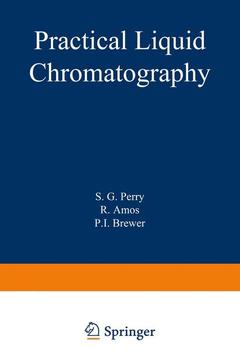Practical Liquid Chromatography, Softcover reprint of the original 1st ed. 1972
Langue : Anglais

This book is intended to provide a practical introduction to high-speed, high-efficiency liquid chromatography. It covers modern column technology (which has leapt into prominence only in the last five years) and relates this to the well-established thin-layer techniques. The development of liquid chromatography has proceeded in fits and starts over many years and in alliance with various scientific disciplines. Liquid chromatography has for years fulfilled an effective role in various fields. Ion-exchange chromatography, for example, is particularly associated with the separation of the rare earths, and exclusion chromatography with the fractionation of naturally occurring materials like proteins and of syn thetic polymers. Partition chromatography, especially in the form of paper chromatography, has been an indispensable tool in the study of biochemical systems, while its more recent adsorption counterpart, thin-layer chromatog raphy, developed most rapidly within the pharmacognosic and pharma ceutical fields. Until recently, however, liquid chromatography has not played a prominent role in the field of industrial organic analysis.
1: Liquid Chromatography—The Background.- 1.1. Perspective.- 1.2. Plan of the Book.- 1.3. Chromatography and Its Basic Variants.- 1.3.1. Adsorption Chromatography.- 1.3.2. Ion-Exchange Chromatography.- 1.3.3. Partition Chromatography.- 1.3.4. Exclusion Chromatography.- 1.4. Development Methods in Chromatography.- 1.4.1. Elution.- 1.4.2. Frontal Analysis.- 1.4.3. Displacement.- 1.5. Basic Experimental Arrangements.- 1.5.1. Column Chromatography.- 1.5.2. Layer Chromatography.- 1.6. Measures of the Effectiveness of Chromatographic Separations.- 1.6.1. HETP.- 1.6.2. Resolution.- 1.7. Retention Parameters.- 1.7.1. Measures of Retention.- 1.7.2. Retention and Identification.- References.- Further Reading.- 2: Band Spreading in Chromatography.- 2.1. Introduction.- 2.2. Factors Leading to Band Spreading.- 2.3. The “Random-Walk” Concept.- 2.4. Simple Mathematics of the Random Walk.- 2.5. Molecular Diffusion.- 2.6. Mass Transfer.- 2.7. Eddy Diffusion.- 2.8. Final Expression for Plate Height.- 2.9. Extrabed Contributions to Band Spreading.- 2.10. Columns versus Plates.- 2.11. Summary—Important Practical Consequences of Theory.- 2.11.1. Choice of Stationary Phase.- 2.11.2. Stationary Phase Particle Size.- 2.11.3. Dimensions of the Stationary Phase Bed.- 2.11.4. Choice of Mobile Phase.- 2.11.5. Mobile Phase Velocity.- 2.11.6. Operating Temperature.- 2.11.7. Availability of Appropriate Instrumentation.- References.- Further Reading.- 3: Adsorption Chromatography: Mechanism and Materials.- 3.1. Introduction.- 3.2. Adsorption Isotherms.- 3.3. Nature of Adsorption Forces.- 3.3.1. Van der Waals Forces (London Dispersion Forces).- 3.3.2. Inductive Forces.- 3.3.3. Hydrogen Bonding.- 3.3.4. Charge Transfer.- 3.3.5. Covalent Bonding (Chemisorption).- 3.4. Choice of Chromatographie System in LSAC.- 3.4.1. Choice of Adsorbent.- 3.4.2. Sample Size and Linear Capacity.- 3.4.3. Adsorbent Standardization.- 3.4.4. Choice of Mobile Phase.- 3.5. Variation of Adsorption Coefficient Kº with Solute Structure.- 3.6. Individual Adsorbents.- 3.6.1. Silica Gel.- 3.6.2. Alumina.- 3.6.3. Magnesium Silicates.- 3.6.4. Magnesia.- 3.6.5. Modified Adsorbents.- 3.6.6. Porous Layer Beads.- 3.6.7. Carbon.- 3.6.8. Ion Exchangers.- References.- Further Reading.- 4: Liquid Partition Chromatography—Mechanism and Materials.- 4.1. Introduction.- 4.2. Thermodynamics of Liquid-Liquid Partition.- 4.2.1. Relation between Partition Coefficient and Solution Properties.- 4.3. Selection of Phase Pairs.- 4.3.1. Selectivity.- 4.3.2. Stability of Phase Pairs.- 4.3.3. Relation of Dynamics to Phase Pair Choice.- 4.4. Support Materials.- 4.5. Further Practical Considerations.- 4.5.1. Preparation of Stationary Phases.- 4.5.2. Liquid Phase “Loading” and Sample Capacity.- References.- Further Reading.- 5: Exclusion Chromatography—Mechanism and Materials.- 5.1. Introduction.- 5.2. Peak Broadening in Exclusion Chromatography.- 5.3. Theories of Exclusion Chromatography.- 5.4. Stationary Phases for Exclusion Chromatography.- 5.4.1. Inorganic Stationary Phases.- 5.4.2. Alkylated Cross-Linked Dextrans.- 5.4.3. Polyvinyl Acetate Gels.- 5.4.4. Polystyrene-Divinyl Benzene Gels.- Appendix: Applications of Exclusion Chromatography.- References.- Further Reading.- 6: The Technique of Thin-Layer Chromatography.- 6.1. Introduction.- 6.2. Outline of Technique.- 6.3. The Stationary Phase.- 6.4. Preparation of TLC Plates.- 6.4.1. Choice of Support.- 6.4.2. Preparation of Slurry.- 6.4.3. Coating the Plate.- 6.4.4. Drying and Storage of Plates.- 6.4.5. Precoated Plates.- 6.4.6. Conclusions.- 6.5. Application of the Sample.- 6.5.1. Analytical Scale.- 6.5.2. Preparative Scale.- 6.6. Choice of Mobile Phase.- 6.7. Development of Chromatogram.- 6.7.1. Tank Development.- 6.7.2. Sandwich Chambers.- 6.7.3. Other Methods of Development.- 6.8. Reproducibility of RF Values.- 6.8.1. Introduction.- 6.8.2. Factors Affecting Reproducibility.- 6.8.3. Conclusions.- 6.9. Detection of Solutes.- 6.9.1. Inspection under Ultraviolet Light.- 6.9.2. Revealing Reagents.- 6.10. Chromatographic Records.- 6.11. Direct Quantitative Analysis on the Layer.- 6.11.1. Introduction.- 6.11.2. Visual Comparison.- 6.11.3. Area Measurement.- 6.11.4. Densitometry.- 6.11.5. Fluorimetry.- 6.11.6. Reflectance Spectrophotometry.- 6.11.7. Radioactive Methods.- 6.12. Removal of Solute from Adsorbent Layer.- 6.12.1. Introduction.- 6.12.2. Adsorbent Purity.- 6.12.3. Solvent Requirements.- 6.12.4. Sample Handling Technique.- 6.13. Use of Ancillary Techniques.- 6.13.1. Spectrophotometry.- 6.13.2. Ultraviolet Fluorescence.- 6.13.3. Other Chromatographie Techniques.- 6.13.4. Infrared Spectroscopy and Mass Spectrometry.- 6.13.5. Flame Ionization Detection.- 6.14. Present Status and Future Outlook.- References.- Further Reading.- 7: Equipment for Column Chromatography.- 7.1. Introduction.- 7.2. Pneumatics.- 7.2.1. Use of Compressed Gas.- 7.2.2. Pumps.- 7.2.3. Peristaltic Pumps.- 7.2.4. Reciprocating Pumps.- 7.2.5. Rotary Pumps.- 7.2.6. Constant-Drive Piston Pumps.- 7.2.7. Methods of Damping Pulsating Flows.- 7.2.8. Solvent Degassing.- 7.3. Gauges.- 7.4. Gradient Elution Supply.- 7.5. Sample Injectors.- 7.6. Columns and Fittings.- 7.7. Grinders and Sizing Equipment.- 7.8. Fraction Collectors.- 7.9. Detectors.- 7.9.1. Introduction.- 7.9.2. Commercialized Detection Systems.- 7.9.3. Experimental Detection System.- Appendix: A Short Guide to Commercial Equipment Suitable for Column Liquid Chromatography.- References.- Further Reading.- 8: Current Status of Liquid Chromatography: Place among Family of Chromatographic Techniques.- References.
Date de parution : 03-2012
Ouvrage de 230 p.
15.2x22.9 cm
Mots-clés :
Diffusion; Sorption; adsorption; bonding; chromatography; development; fields; fluorescence; paper; polymer; proteins; spectroscopy; structure; thermodynamics; ultraviolet
© 2024 LAVOISIER S.A.S.



